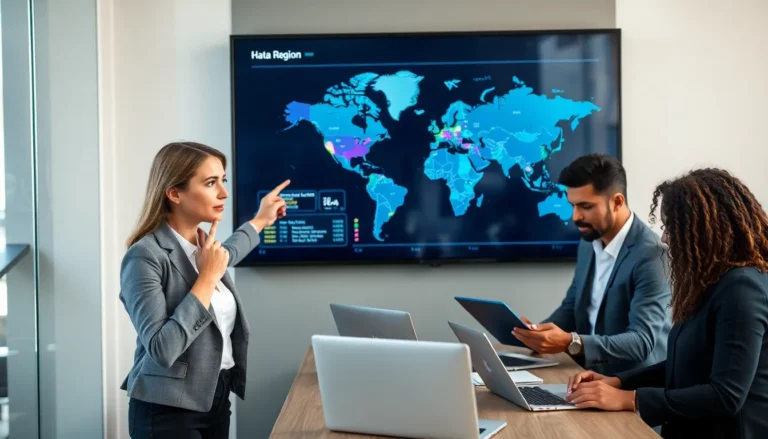In a world where kids can navigate the internet faster than their parents can say “screen time,” parental controls have become the superhero sidekick every parent needs. With the digital landscape evolving at lightning speed, it’s no wonder parents are feeling like they’re chasing a toddler on a sugar high. But fear not! Parental controls are here to save the day, offering peace of mind while keeping those tiny tech wizards in check.
Table of Contents
ToggleUnderstanding Parental Controls
Parental controls play a vital role in creating a safer online environment for children. These tools allow parents to regulate their children’s online activities and screen time.
Definition of Parental Controls
Parental controls refer to various software features and applications that help manage access to content and monitor online behavior. Tools can block inappropriate websites, filter search results, and limit screen time. Different devices, such as smartphones and tablets, offer built-in parental control settings, enhancing protection. These controls empower parents to make informed decisions about what their children can access online.
Importance of Parental Controls
Importance lies in safeguarding children from potential online dangers. With the vast amount of accessible content on the internet, children encounter risks, including cyberbullying and exposure to explicit material. Parental controls provide a layer of security, enabling parents to create a healthy digital experience. Establishing boundaries through these tools encourages responsible screen time habits. They also facilitate open communication between parents and children about online safety and responsible digital citizenship.
Types of Parental Controls
Parental controls come in various forms, each offering distinct functionalities to enhance child safety online. Understanding these types helps parents choose the most suitable options.
Software-Based Parental Controls
Software-based parental controls offer numerous features for monitoring and restricting online activities. Common applications include filtering content, tracking browsing history, and limiting screen time on devices. Some programs enable parents to block specific websites or applications that may not be age-appropriate. Many software solutions also allow remote management, meaning parents can adjust settings from anywhere. Examples include Norton Family and Kaspersky Safe Kids, popular among families for their comprehensive capabilities.
Hardware-Based Parental Controls
Hardware-based parental controls involve physical devices that regulate internet access. Routers equipped with built-in parental control settings can restrict certain websites or limit access to the internet during specific hours, facilitating easier management of family screen time. Many modern routers provide features like device prioritization and the ability to pause internet access for specific devices. These controls work at the network level, ensuring that every device connected to the network adheres to the established rules.
Built-In Device Settings
Built-in device settings enhance parental control through features integrated into smartphones, tablets, and computers. Common functionalities include content restrictions, usage tracking, and the ability to set time limits. For example, Apple’s Screen Time and Google’s Family Link provide tools to manage children’s app usage and screen time effectively. Users should explore their devices’ settings to find customized options that meet their family’s needs. Such built-in solutions foster responsible device use, creating an environment conducive to discussions about digital safety.
Features of Effective Parental Controls
Effective parental controls encompass several key features that empower parents to safeguard their children online. These features include content filtering, time management, and monitoring and reporting tools.
Content Filtering
Content filtering plays a crucial role in ensuring children only access age-appropriate material. Parents can block specific websites or categories, like adult content or violent games. Customizable settings allow flexibility, catering to individual family values and children’s needs. Providers often update their filtering lists, adapting to new online threats and trends. Effective content filters minimize children’s exposure to harmful content while still permitting access to educational resources and entertainment.
Time Management
Time management features help parents regulate their children’s screen usage effectively. Specific tools enable setting daily or weekly limits on device use. Parents can also schedule specific times for device access, promoting a balanced approach to technology. Alert notifications can remind children when their time is running out, fostering responsibility and respect for limits. With effective time management features, it’s easier to encourage offline activities and family interactions.
Monitoring and Reporting
Monitoring and reporting tools provide insights into children’s online behavior. Parents can track browsing history and app usage, pinpointing potential risks in real time. Reports often summarize activity patterns, revealing trends that warrant attention. Some advanced systems even alert parents of inappropriate searches or communications, enabling swift action. This proactive approach cultivates a safer online experience for children while facilitating ongoing discussions around digital responsibility.
Popular Parental Control Tools
Parents often seek effective tools to manage their children’s online activities. Numerous options exist, each tailored to specific needs.
Overview of Top Software
Popular parental control software includes Qustodio, Norton Family, and Net Nanny. Qustodio offers comprehensive features, including real-time monitoring and location tracking. Norton Family excels in managing web filtering and time controls, making it user-friendly. Net Nanny stands out for its advanced social media monitoring capabilities. Each program provides mobile compatibility, ensuring parents can oversee their children from various devices. These options help parents create a safer digital space.
Comparing Device-Specific Features
Device-specific parental controls vary significantly between platforms. Apple devices offer Screen Time, providing content restrictions and usage tracking directly within settings. Android provides Digital Wellbeing, which focuses on app limits and activity tracking. Windows allows users to set up accounts with specified access levels and time management controls. Each platform’s unique features cater to different parental preferences, ensuring choices align with individual family needs. Families can utilize these built-in controls alongside third-party tools for enhanced protection.
Navigating the digital landscape can be challenging for parents. By leveraging parental controls, they can create a safer online environment for their children. These tools not only help manage screen time but also foster responsible digital habits.
With various options available, parents can choose the right combination of software and built-in settings to suit their family’s needs. Establishing these boundaries encourages open conversations about online safety. Ultimately, embracing parental controls empowers parents to guide their children through the complexities of the internet while ensuring a balanced and secure digital experience.









